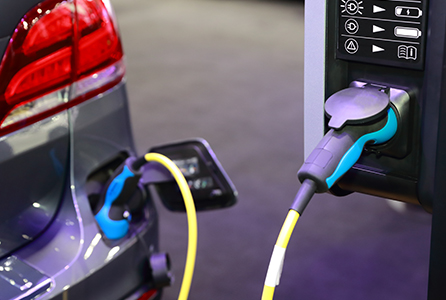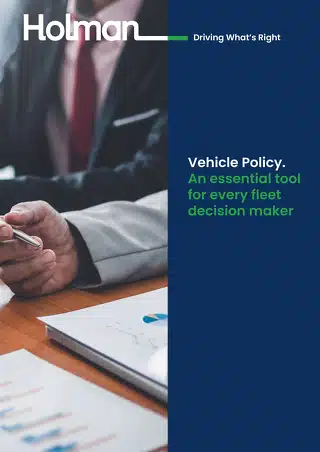-
What We DoFrom fleet management and productivity solutions to upfitting, fabrication, and insurance, Holman has the integrated automotive services expertise to keep your business moving.Overview
-
ResourcesWe have a lot to share. Browse our resources library for current insights, data, strategies, and success stories from our own experts in their respective fields.Overview
-
About UsWhen Holman was founded in 1924, we set something positive in motion. Our consistent focus on people and our commitment to integrity make us who we are today.Overview
 Join Our TeamWe’re not just in the automotive business, we’re in the people business. Join us for the ride.Browse Careers
Join Our TeamWe’re not just in the automotive business, we’re in the people business. Join us for the ride.Browse Careers
The Importance of Electric Vehicle Infrastructure
Holman Marketing
October 17th, 2022

EV Infrastructure – what is it, and what does it mean for your business?
You’re never far from a petrol station from the tip of Cornwall to the top of Scotland. There are over 8,000 petrol stations in the UK. Easy access to fuel is critical to commercial fleets – and it’s currently a significant barrier to the mass adoption of EVs. Before BEVs replace diesel-powered fleets, we’ll need massive investment in infrastructure, say experts.
EVs aren’t future tech; industry experts predict that EVs will dominate fleets by 2025 – but there are barriers we need to overcome, including the speed and availability of charging infrastructure. Before fleet managers make the leap, they need the confidence that there will be power when required. It’s National Drive Electric Week this month, so we thought we would look at what EV infrastructure is and why a rapid rollout is critical to the future of your commercial fleet.
What is EV Infrastructure?
EV infrastructure is the technical term for the charging technology needed for the powerful batteries inside electric vehicles. We won’t go too deep into the different types of charging technology, but most EV chargers for passenger and light-commercial vehicles deliver AC charge to a vehicle. The in-built transformer changes this to DC for its internal battery. It’s not quick, with charging taking between 2-12 hours. There are two types of chargers, Level 1 and Level 2.
Level 1 chargers use a standard AC110/120 plug socket outlet to charge a vehicle. Level 2 chargers use a dedicated AC 220/240-volt outlet (the same type used on your kitchen range cooker) to supply a charge. They’re much faster than Level 1 chargers, but not the fastest.
A range of DC chargers (known as Level 3 chargers) can deliver high amounts of power directly to a vehicle’s battery (without going through a transformer). These use the European standard CCS1 & 2 Pinout connectors and can fully charge a vehicle battery in minutes, not hours. They’re super-efficient but more expensive, so you’ll only find them installed commercially.
When investing in an EV fleet, there’s more to consider than the size and type of vehicle. You also need to consider vehicle range and charging type. Alongside your vehicle purchase (or rental), you’ll also need to ensure you have the charging infrastructure available.
Fleet operators have three infrastructure options:
- Install EV chargers at your drivers’ homes
- Install EV charging at your business premises (depot)
- Access public chargers
1. Install EV chargers at your drivers’ homes
You can install EV charging at your drivers’ homes so they can charge their vehicles overnight. To do this safely, they’ll need a designated off-road space, such as a garage or driveway. Of course, you’ll need to reimburse your drivers for charging, but this is still the most cost-effective way to do it, as domestic energy tariffs are (currently) lower than commercial ones.
2. Install EV charging at your business premises
Operators can rent charging equipment from a growing range of ChargePoint companies. You’ll typically find Level 2 and Level 3 chargers that can rapidly recharge vehicles. Your drivers can drop them off at the depot and pick them up fully charged the next day. In addition, you can set your chargers to work intelligently, charging at off-peak times when prices are at their lowest.
3. Access public chargers
It’s not ideal (and it’s expensive), but your drivers may need to access public chargers. While unsuitable for everyday charging, they can deliver essential energy when required. Currently, the charging infrastructure is patchy across the UK, but the situation is improving.
What EV infrastructure do we need?
When a van driver runs low on diesel, they can grab the corporate credit card and fill up in minutes. If they’re driving an EV, they’ll need to search for a charger and sit there until the battery is sufficiently charged. It’s far from ideal, but the Government has a plan to fix it.
There’s agreement among fleet operators that there’s an urgent need for faster-charging infrastructure. However, EV infrastructure in the UK is fragmented and is quite understandably clustered around cities. To power the EV revolution, the Government is investing almost £1bn in 6,000 high-powered chargers across the road network by 2035.
Instead of having to search out EV infrastructure, operators can have faith that their drivers will be able to find the energy they need. But 2035 is a long way away, and there’s recognition that this isn’t fast enough for business, so the Government is looking to reduce red tape and offer more support for fleet operators. It will provide a welcome boost when energy prices are rising across the board.
What challenges is the fleet industry facing?
Holman’s Director of Sustainability, Emily Graham, and Manager of EV Consulting, Chelsea Feast, agree that there are three critical challenges facing the fleet industry:
- Supply chain delays – A global shortage of EVs is slowing the transition. However, even a short delay enables our experts to help ensure that the plans you’re putting in place are future-proof.
- Selecting a transition strategy: Holman works with the customer to develop a strategy for EVs that’s right for you. It’s not simply about choosing vehicles. There are three key focus areas:
- Vehicle fit – what is the right vehicle/fleet for their business today and tomorrow?
- Charger fit (home, depot, or public)
- Driver fit – Driver management, policies, and education
- Unlocking cost/efficiencies and savings –At Holman, we take a lifecycle approach to ownership, maximising value at every stage. Whether you want to shift your entire fleet to EVs or introduce them in a phased way, we can support your strategy to deliver the highest cost and efficiency savings.
Unsure of the EV infrastructure you need? Let Holman help
We know that the EV ecosystem can be overwhelming. There is a lot of noise from sustainability companies, utility providers, manufacturers, and providers of EV charging infrastructure. With rising costs of electricity impacting the benefits (e.g. costs of charging), will this influence consumer purchasing and impact the EV market significantly? Is EV still a greener, more cost-efficient option?
So many questions. So, who can you trust to provide you with some answers? At Holman, we continue to monitor developments and data in the electrification space to anticipate future requirements and trends to support our customers. We’ve already done the research, and our experts are best placed to deliver a streamlined sustainable solution that adds value to your business.
Next Post
5 Tips To Futureproof Your VehicleRelated Resources
Explore more related industry news, insights, and developments.
It looks like you've navigated to our Holman UK website and are located outside of this region. Would you like to continue or select a different region?
✕






